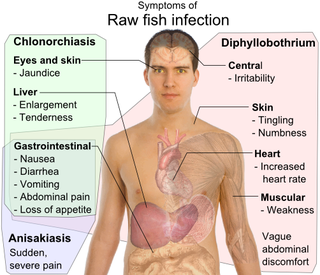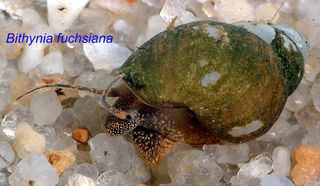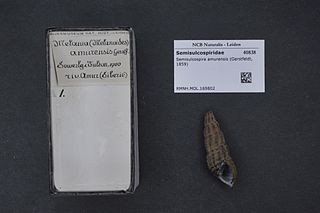
Clonorchis sinensis, the Chinese liver fluke, is a liver fluke belonging to the class Trematoda, phylum Platyhelminthes. It infects fish-eating mammals, including humans. In humans, it infects the common bile duct and gall bladder, feeding on bile. It was discovered by British physician James McConnell at the Medical College Hospital in Calcutta (Kolkata) in 1874. The first description was given by Thomas Spencer Cobbold, who named it Distoma sinense. The fluke passes its lifecycle in three different hosts, namely freshwater snail as first intermediate hosts, freshwater fish as second intermediate host, and mammals as definitive hosts.

Clonorchiasis is an infectious disease caused by the Chinese liver fluke and two related species. Clonorchiasis is a known risk factor for the development of cholangiocarcinoma, a neoplasm of the biliary system.
Opisthorchis viverrini, common name Southeast Asian liver fluke, is a food-borne trematode parasite from the family Opisthorchiidae that infects the bile duct. People are infected after eating raw or undercooked fish. Infection with the parasite is called opisthorchiasis. O. viverrini infection also increases the risk of cholangiocarcinoma, a cancer of the bile ducts.

Bithynia tentaculata, common names the mud bithynia or common bithynia, or faucet snail is a relatively small species of freshwater snail with gills and an operculum, an aquatic prosobranch gastropod mollusk in the family Bithyniidae.

Bithynia is a genus of small freshwater snails with an operculum, aquatic prosobranch gastropod mollusks in the family Bithyniidae.

Radix rubiginosa is a species of air-breathing freshwater snail, an aquatic pulmonate gastropod in the family Lymnaeidae, the pond snails.
Austropeplea ollula is a species of air-breathing freshwater snail, an aquatic pulmonate gastropod mollusk in the family Lymnaeidae, the pond snails.

Echinostoma revolutum is a trematode parasites, of which the adults can infect birds and mammals, including humans. In humans, it causes echinostomiasis.

Opisthorchiidae is a family of digenean trematodes. Opisthorchiidae have cosmopolitan distribution.

Bithynia fuchsiana is a species of small freshwater snail with a gill and an operculum, an aquatic gastropod mollusk in the family Bithyniidae.
Bithynia longicornis is a species of freshwater snail with a gill and an operculum, an aquatic gastropod mollusk in the family Bithyniidae.
Bithynia misella is a species of freshwater snail with a gill and an operculum, an aquatic gastropod mollusk in the family Bithyniidae.

Amuropaludina chloantha is a species of freshwater snail with a gill and an operculum, an aquatic gastropod mollusk in the family Viviparidae.
Parafossarulus striatulus is a species of freshwater snail with gills and an operculum, an aquatic prosobranch gastropod mollusk in the family Bithyniidae.
Austropeplea viridis is a species of air-breathing freshwater snail, an aquatic pulmonate gastropod mollusk in the family Lymnaeidae, the pond snails.

Semisulcospira libertina is a species of freshwater snail with an operculum, an aquatic gastropod mollusk in the family Semisulcospiridae. Widespread in east Asia, it lives in China, Taiwan, Korea, Japan, and the Philippines. In some countries it is harvested as a food source. It is medically important as a vector of clonorchiasis, paragonimiasis, metagonimiasis and others.

Metagonimus yokogawai is a species of a trematode, or fluke worm, in the family Heterophyidae.
Parafossarulus anomalospiralis is a species of freshwater snail with gills and an operculum, an aquatic prosobranch gastropod mollusk in the family Bithyniidae.

Koreoleptoxis amurensis is a species of freshwater snail with an operculum, an aquatic gastropod mollusk in the family Semisulcospiridae.
Carcinogenic parasites are parasitic organisms that depend on other organisms for their survival, and cause cancer in such hosts. Three species of flukes (trematodes) are medically-proven carcinogenic parasites, namely the urinary blood fluke, the Southeast Asian liver fluke and the Chinese liver fluke. S. haematobium is prevalent in Africa and the Middle East, and is the leading cause of bladder cancer. O. viverrini and C. sinensis are both found in eastern and southeastern Asia, and are responsible for cholangiocarcinoma. The International Agency for Research on Cancer declared them in 2009 as a Group 1 biological carcinogens in humans.











